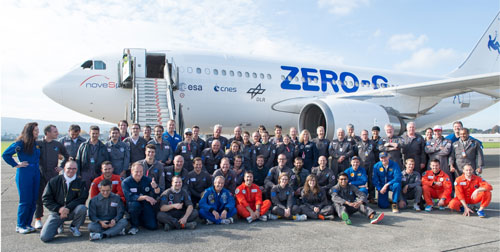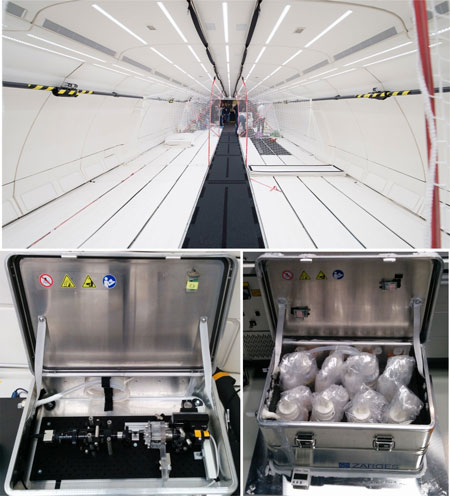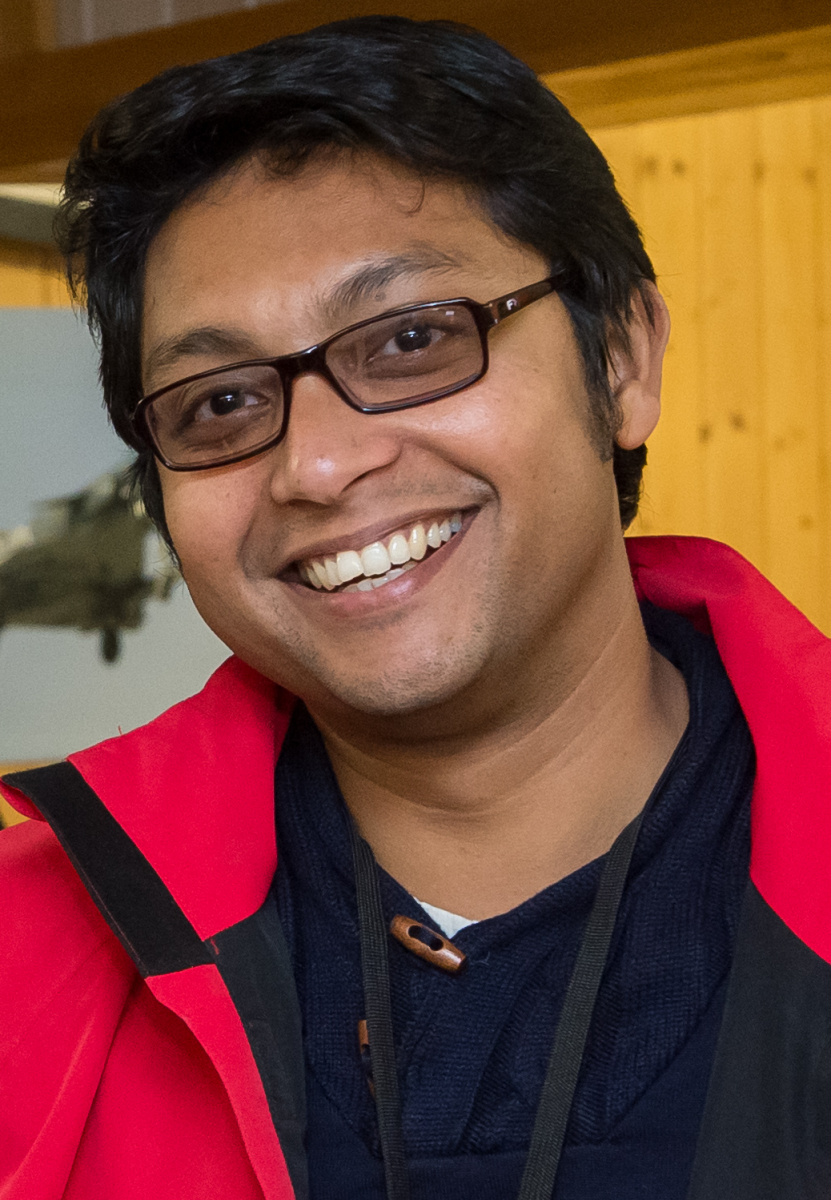Anupam Sengupta, a 2014 HFSP Cross-Disciplinary Fellow, recounts how he was able to test the effects of gravity on phytoplankton migration when he was selected to participate in an expedition on a parabolic flight at 8000m above sea level.
|
|
As I opted out of my comfort zone, leaving my somewhat deterministic life of a physicist, little did I know what it would take to retrain myself as a biologist, and to understand the ways of one of the smallest living organisms in our immediate ecosystem. I work with phytoplankton – organisms which abound our lakes and oceans, and despite their minute dimensions, they play a vital role in our daily lives. These photosynthetic organisms, ranging from a hundredth to a thousandth of the size of a sand grain, maintain Earth’s biogeochemical cycles, produce 50 % of the oxygen that we breathe, and provide an alternative and valuable form of biofuel in a world plagued with incessant environmental challenges. Known to live as passive drifters or as active swimmers, phytoplankton are constantly exposed to fluid flow. It is, however, still a mystery how numerous phytoplankton species are capable of swimming through the turbulent ocean waters to perform their customary diurnal vertical migrations: swimming against gravity to the sunlit surface waters during the day, and downwards, to the nutrient-rich deeper waters, at night.
One month into my new life as a postdoctoral fellow at MIT, I was intrigued to discover how a fraction of a phytoplankton population could rapidly switch its swimming direction when exposed to physical cues that resembled turbulent eddies in an ocean. Three years, and a few hundred experiments later, we can say that such behavioral adaptation is triggered by the changes in direction of gravity relative to the swimming direction of the cell: a frequent occurrence in the life of plankton as they regularly get trapped in eddies. This discovery (a story I hope to share on another occasion) propelled a well-informed hypothesis – gravity acts as a cue for phytoplankton migration – which if true, would imply that changes in the gravity forces themselves can potentially influence these silent phytoplankton migrations. Thus, the Gedankenexperiment to test this hypothesis should be able to tune the strength of gravity without complicating the surrounding fluid flow, while allowing the cells to keep swimming freely – a combination that can readily become challenging, and difficult to realize under standard laboratory settings. However, this wishful thought experiment turned into a reality on October 22, 2016, when I took off on board a Zero-G flight (also known as the parabolic flight), with two experiments and one question: how does a microscopic phytoplankton cell perceive changes in gravity?

Flyers of the Swiss Parabolic Flight Campaign 2016 pose in front of the Zero-G flight after touch down at the Dübendorf airbase. Image courtesy: Regina S (Novespace).
An Airbus A310, although innocuous at a first glance, was remodeled into a Zero-G flight, with designated spots allotted for each experiment to fit in. The phytoplankton experiment was one of the seven experiments selected from a call for the 2nd Swiss Parabolic Flight Campaign, the first full-scale Swiss research expedition into microgravity, which received support from the Swiss Space Office, the State Secretariat for Education, Research and Innovation of the Swiss Confederation (SERI) and University of Zurich’s Swiss Parabolic Flights initiative. The experiments were designed and constructed meticulously over quarter of a year, and tested to a painstaking detail to meet the rigorous safety requirements of the micro- and hyper-gravity conditions on board.
Upon receiving the mandatory safety clearance from Novespace (subsidiary of the French Space Agency, CNES, which conducted the parabolic flight), it was time to finally experience weightlessness – for me, my cells, and my team members – all on our maiden voyage to the microgravity environment.

Decking the Airbus A310 into a Zero-G flight. An overhauled passenger jet for conducting experiments under microgravity conditions (top) Image courtesy Regina S (Novespace). The phytoplankton experiments on board Zero-G flight: real time visualization set up (bottom, left), and molecular experiment (bottom, right).
Through a series of parabolic manoeuvers, about 8000 meters above the Mediterranean Sea, we experienced 14 cycles of microgravity, and a cycle each of Martian and lunar gravity, all of them lasting 22 seconds. Alongside a combination of real time visualization set up (imaging individual microscopic cells as they swam) and a molecular experiment (to assess the changes in gene expression as a result of the changes in gravity), we acquired valuable experimental data, which will help reveal the mechano-genetic underpinnings of gravity perception in phytoplankton. Each weightlessness phase was flanked by 20 second long hypergravity intervals, during which the world turned twice as heavy relative to the usual Earth conditions. Interestingly, as scientists, we were (once again) a minority: the majority of my co-flyers were space enthusiasts, and patrons of science, who came from Europe and afar for the pure joy of experiencing weightlessness.
Notwithstanding the invaluable experimental opportunity, for me, the parabolic flight – a journey to the skies to fathom the depth of oceans – carried a special personal meaning: it was a perfect example of the vision of cross-disciplinary science that I have grown up with. This was coming full circle, as the very reasons which took me away from the comfortable life of a physicist, brought me back to physics again. My maiden experience of weightlessness – a feeling so priceless and unforgettable – swiftly ferried me to the heart of the fundamental laws of physics – the ones which govern us, but often go unnoticed amidst the mundane things that tend to take control of our lives on the ground. The build up to the parabolic flight was strenuous but the sheer might of gravity – or the lack of it – erased away any inkling of weariness. After the 16 rounds of parabolae, we finally touched down at the Dübendorf airbase – to welcoming applause from the ground staff, family members, and local media seeking a quick news bite. It was a feeling of joy, glory and achievement for many. For me, it was a time to reflect on this incredible journey – one which came with its fair share of daunting challenges, countless little anecdotes, and limitless vistas for the next journey ahead.
A light moment on board Zero G parabolic flight (video)



































 Anupam Sengupta is an HFSP Cross-Disciplinary Fellow researching at the broad interface of fluid dynamics, marine biology, material sciences and theoretical ecology. He is a mechanical engineering graduate of the Indian Institute of Technology Bombay and holds a PhD in Physics for his work on Liquid Crystal Microfluidics, co-advised by Christian Bahr and Stephan Herminghaus, at the Max Planck Institute for Dynamics and Self Organization, Göttingen, Germany. In 2014, Anupam Sengupta switched fields and moved to MIT in Cambridge, USA with the HFSP Cross-Disciplinary Fellowship to work on biophysical processes in marine environments with Roman Stocker. Since October 2015, he is based in Zurich, Switzerland, and continues his research at the Institute of Environmental Engineering at ETH Zurich. Link to
Anupam Sengupta is an HFSP Cross-Disciplinary Fellow researching at the broad interface of fluid dynamics, marine biology, material sciences and theoretical ecology. He is a mechanical engineering graduate of the Indian Institute of Technology Bombay and holds a PhD in Physics for his work on Liquid Crystal Microfluidics, co-advised by Christian Bahr and Stephan Herminghaus, at the Max Planck Institute for Dynamics and Self Organization, Göttingen, Germany. In 2014, Anupam Sengupta switched fields and moved to MIT in Cambridge, USA with the HFSP Cross-Disciplinary Fellowship to work on biophysical processes in marine environments with Roman Stocker. Since October 2015, he is based in Zurich, Switzerland, and continues his research at the Institute of Environmental Engineering at ETH Zurich. Link to